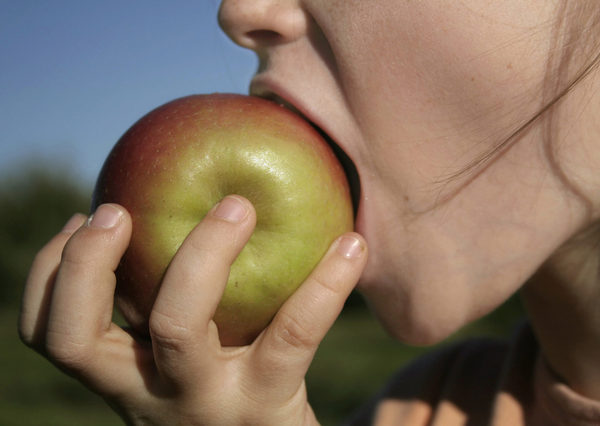March is Nutrition Month, a time to bring awareness to the benefits of consuming a healthy balanced diet. This year, the Nutrition Month Campaign, led by Dietitians of Canada, is dedicated to encouraging individuals to make small dietary changes under the slogan “Take a 100 meal journey: make small changes, one meal at a time.” This is based on the premise that we eat about 100 meals in a month, so the idea is to focus on making a small, lasting change that will stick… one meal at a time.
Of course, as a dietitian, I’m committed to supporting this initiative both through sharing information about how to achieve change and by pledging to make a change myself. If I’m honest, I have never naturally gravitated towards eating fruit as a snack or even with my meals (unless we’re talking my favourite apple pie!). So endeavouring to eat 3 servings of fruit each day seemed like a worthwhile goal, especially given the potential health benefits to be reaped by this change. I also believe that this is a pretty achievable SMART (i.e. Specific, Measureable, Action-orientated, Realistic, Timeframe) goal. Last week I even shared my pledge on social media because accountability and support from friends and relatives are key drivers of success.
Here we are, 7 days into March, and I had intended on sharing with you all the great things I have been doing to eat more fruit, plus how motivated and great I feel. But edit that… the truth is that I have made zero progress towards achieving my goal. In fact on Thursday my fruit consumption consisted of a small glass of orange juice, and even though fruit juice is classified as part of the Vegetables and Fruit group in Canada’s Food Guide, we all know that it doesn’t really count! My average fruit consumption has probably been wavering at one measly serving a day. I could now list all the reasons why I simply didn’t get around to eating more fruit (you know, like I grabbed a banana but it was brown and mushy…..I cut up a mango but my daughter ran off with my bowl … I didn’t make it to the grocery store…) but the truth is old habits die hard!
Decisions surrounding eating are a dynamic interaction between our knowledge of nutrition, our food ‘rules’ or established eating habits, our immediate environment, and our internal cues. This means that, in my case, possessing expertise in nutrition is not a sufficient lever for initiating change. In fact, we have a tendency to focus on the type of foods that we should be eating and their positive or negative impact on our health, BUT relatively little time is spent talking about HOW we eat and the factors that influence our decisions to eat.
How many decisions do you think you make about food each day? 6? 15? 50? Dr. Brian Wansink Director of the Food and Brand Lab at Cornell University studied this question and discovered that on average people estimated that they made 14 food related decisions each day but actually made 227! Just think about it for a minute. From the moment you get up you’re asking yourself if you’re hungry, if you’re going to have breakfast, what are you going to have for breakfast, the size of serving you’re going to make, are you going to have a second serving or anything else to eat, where are you gong to eat it, what are you going to drink with that? Some of these questions are conscious but many are unconscious. Consequently, changing our environment can be one way of creating visual cues that will encourage us to subconsciously make positive eating decisions, and if something is convenient to do then it is more likely to become part of our daily routine. Hooray to that!
Here are a few easy fixes to your environment that Dr Wansink and his Research Team have discovered:
- Out of Sight, Out of Mind. Foods left out are twice as likely to be eaten than foods that are kept out of sight. Adjust eye-level foods:
- Clear kitchen counters of all food except for a bowl of fresh fruit for crunchy snacking.
- Keep small bowls of fruit in other places around the house like on the reception desk, dining room table, living room mantle.
- Keep a water bottle/jug on your work desk, counter, dining table for easy sipping throughout the day.
- Rearrange Your Cupboards and Refrigerator. You are three times more likely to eat the first food you see than the fifth food.
- Keep nourishing snacks (e.g. hardboiled eggs, cut up fruit and veggies, yogurt, nuts, wholegrain crackers) on an eye-level shelf in the fridge or cupboards so something healthy is the first thing you see.
- Put high-fat, high-sugar treats, such as cookies, into non-transparent containers at the back of the fridge or cupboard so they’re out of sight
- Minimize Mindless Eating.
- Only eat in the kitchen or dining room (and eat away from your work desk). Turn off screens during meals to reduce the incidence of distracted eating and the likelihood that you will overeat or make less healthy food choices.
- Dish it Up. You consume 30% more calories if the serving bowl is left on the table.
- Serve food, or have family members serve themselves, from the counter or the stove and leave the serving bowl in the kitchen. Conversely, keep serving dishes of vegetables on the table. If you’re still hungry, eat second portions of veggies.
- Size Matters. You consume 50% more calories when eating from a large plate.
- To curb overeating, use smaller plates and bowls (<11” in diameter). You will eat less calories but still feel satisfied.
In his book “Mindless Eating”, Dr. Wansink advocates that the best diet is the diet that you don’t know you’re on …. While this sounds great and I do agree with him to a point, I also believe that we need to learn to tune in to our internal cues and to eat mindfully …. But that is a whole other blog post! For now, I will focus on the remaining 24 days of March to develop my new fruit eating habit. I will definitely be adopting the first two actions above. What small change can you make? We might be a week in to the challenge but it’s not too late to pledge to make a change. First think about your current diet, identify a small change, and start by adjust your eating environment to facilitate this change. Together we can all eat healthier!
*Adapted from the Dietitians of Canada’s Nutrition Month campaign materials. Find out more about Nutrition Month at: www.NutritionMonth2016.ca
Find more healthy eating tips at: http://www.dietitians.ca/Your-Health/ and https://www.eatrightontario.ca/
Find more about Dr. Wansink’s work at:






 Mac says
Mac says
March 9, 2016 at 5:28 pmGreat post Naomi, love the suggestion about putting healthy food at the front of the fridge.
 Monte Deloach says
Monte Deloach says
September 19, 2024 at 2:56 pmAmazing Content! If you need some details about about Thai-Massage than have a look here UY4